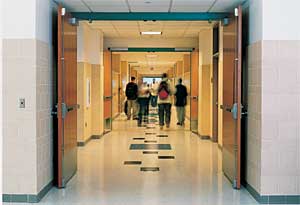Access Control: Delivering Security, Life Safety, and Convenience
Door Locking Hardware
Mortise locks fit into a mortise in the door edge, and typically feature levers to operate a latchbolt. They provide greater torque resistance, security, and variety of functions than typical cylindrical locksets, and are recognizable by the separate key cylinder above the lever. Mortise locks can be applied to any door in a facility that requires latching or locking and does not require panic hardware. The brute strength of a mortise lock makes it a popular choice for securing sensitive areas such as executive offices, storage closets, computer and medical labs, and stairwell doors.
Cylindrical locks are a step down from the strength and durability of a mortise lock and are more appropriate for securing interior openings. A cylindrical lock requires less door preparation than a mortise lock and is also less expensive and easier to install.
|
Exit devices, also known as panic hardware, allow safe egress while restricting access from outside a building. Exit devices consist of a push pad or bar which extends across the push side of the door. When depressed, the device retracts a latchbolt to allow the door to be pushed open. These are one-way valves through which people can exit but cannot enter unless authorized. Life safety codes establish occupancy or space requirements that dictate which doorways must be equipped with an exit device. Generally, rooms within education, healthcare, and assembly occupancies with an occupant load greater than 50 persons will require panic hardware.
Electromechanical versions of mortise locks, cylindrical locks, and exit devices enhance access control by requiring ID credentials such as a keypad, card or proximity reader, key fob, or biometric identification device. They also feature fail-safe or fail-secure options in the event of power loss. A fail-safe device becomes unlocked in the event of a power failure, while a fail-secure lockset is automatically locked. Linking the locks to a centralized computer system permits constant monitoring of the doorways. If a door is propped open, for example, the computer will immediately detect the anomaly and warn of the possible security breach. This requires the use of a door position switch.
Exit devices offer the greatest number of electromechanical functions. Delayed egress exit devices sound an alarm and remain locked for 15 seconds when the push bar is pressed. After the 15-second delay, the push bar is unlocked and egress is allowed. This is an ideal application for openings where material could be snuck out a back door. In the past, the best available option was an exit alarm, which would merely alert facility personnel that someone might have walked off with something. Delayed egress devices give personnel time to apprehend a would-be thief, and become a significant deterrent against theft. Another electronic exit device function is the electric latch retraction exit device. This device operates as a normal exit device until power is applied. When power is applied to the device, its latchbolt is retracted, and the door can be pulled (or pushed) open without depressing the push rail or operating any trim, such as a lever. This can be applied to an entrance that may either have a card reader for access or be remotely controlled by a time clock or other switching device. Some devices actually retract both the latchbolt and the push rail on the exit device, making the device completely silent when operated. This is ideal for auditoria, theaters, music rooms, or any other space where acoustics and quiet door operation are important.










